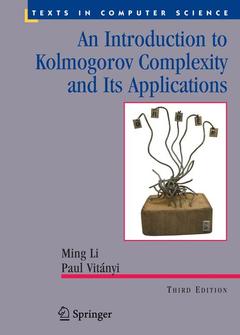Description
An Introduction to Kolmogorov Complexity and Its Applications (3rd Ed., 3rd ed. 2008)
Texts in Computer Science Series
Authors: Li Ming, Vitányi Paul M.B.
Language: English
Subjects for An Introduction to Kolmogorov Complexity and Its...:
Approximative price 79.11 €
In Print (Delivery period: 15 days).
Add to cart792 p. · 17.8x25.4 cm · Paperback
Description
/li>Contents
/li>Comment
/li>
?The book is outstanding and admirable in many respects. ... is necessary reading for all kinds of readers from undergraduate students to top authorities in the field.? Journal of Symbolic Logic
Written by two experts in the field, this is the only comprehensive and unified treatment of the central ideas and applications of Kolmogorov complexity. The book presents a thorough treatment of the subject with a wide range of illustrative applications. Such applications include the randomness of finite objects or infinite sequences, Martin-Loef tests for randomness, information theory, computational learning theory, the complexity of algorithms, and the thermodynamics of computing. It will be ideal for advanced undergraduate students, graduate students, and researchers in computer science, mathematics, cognitive sciences, philosophy, artificial intelligence, statistics, and physics. The book is self-contained in that it contains the basic requirements from mathematics and computer science. Included are also numerous problem sets, comments, source references, and hints to solutions of problems. New topics in this edition include Omega numbers, Kolmogorov?Loveland randomness, universal learning, communication complexity, Kolmogorov's random graphs, time-limited universal distribution, Shannon information and others.
Develops Kolmogorov theory in detail and outlines the wide range of illustrative applications
Presents recent, major results in the field; topics include, Omega numbers, Kolmogorov-Loveland randomness, universal learning, communication complexity, Kolmogorov's random graphs, time-limited universal distribution, Shannon information
Introduces results from prominent researchers in the field, such as those found by Slaman-Kucera, Downey, Hirschfeldt, Nies, Solovay, Miller and many more
Includes applications to hierarchical clustering, phylogeny in genomics, classification of music, Google, and the World Wide Web
Additional exercises on new results
Improved sections on high-probability properties and Kolmogorov’s structure function, information distance
Includes supplementary material: sn.pub/extras




